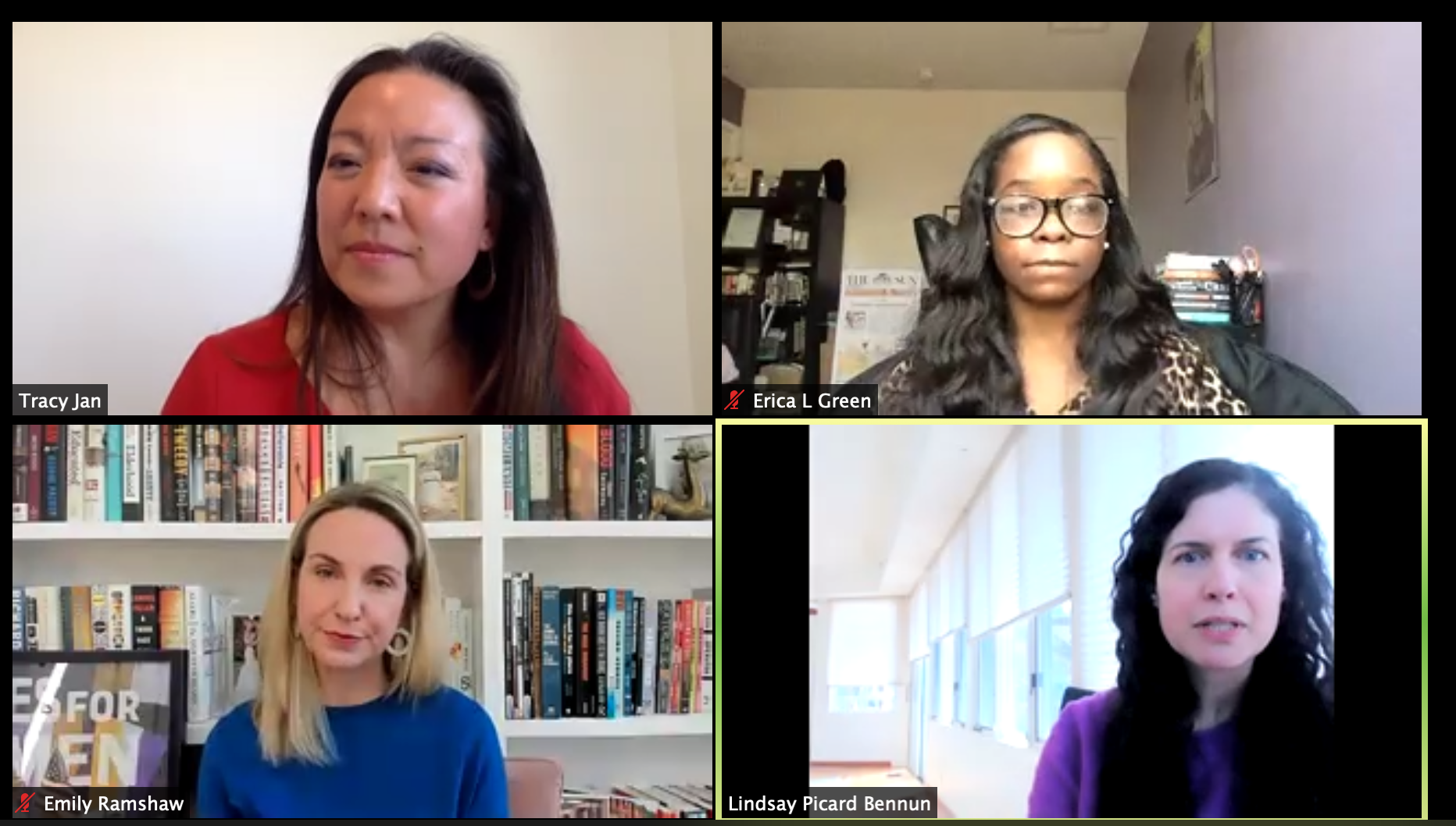Intentionality behind incorporating race and equity into all areas of reporting is the epitome of effective journalism, according to the panelists who spoke at today’s “Panel on Race and Media.”
The three female journalists, two of whom are women of color, agreed that there is much work to be done to combat inequities in media. As reporters and leaders on the national stage, the panelists — New York Times reporter Erica Green, Washington Post reporter Tracy Jan ’98 M.A. ’99 and The 19th co-founder and CEO Emily Ramshaw — are keenly aware of the gender and racial disparities that prevail in newsrooms. Through their own storytelling, they are actively trying to change that.
“If you’re covering education without confronting race, you should not be covering education,” said Green, who covers education for The New York Times.
The other panelists at the event, a part of the Stanford Women’s Network’s 100+ Project celebrating and scrutinizing the 100th anniversary of the ratification of the 19th Amendment, underscored that Green’s remark applies beyond the education space. They agreed that purposeful reporting must be actively and unabashedly inclusionary.
“I don’t cover Black students or students of color in general because I’m a person of color,” Green explained. “I cover it because that is the story of education in this country.”
Green, who worked at The Baltimore Sun before joining The Times in 2017, said she experienced fear and self-doubt during her transition. These feelings were, in large part, rooted in the fact that newsrooms like that at The Times have historically been majority male and white. When she joined The Times, Green committed herself to centering equity and exposing injustice through her reporting.
“I made it my mission to get as many children of color on the front page of that paper as I could,” Green said, explaining that she strives to do so “for the right reasons — and that’s justice.”
She cited her story on the disparate treatment of Black girls in schools, as well as her acclaimed investigation into a Louisiana prep school that propelled underprivileged students of color to elite colleges while doctoring their applications, as examples of the actualization of her philosophy.
Jan, who wrote and edited for The Daily during her time at Stanford, applies a similar lens to her The Washington Post beat, which explores the intersection of race and the economy. Jan’s coverage has spanned topics including reparations, systemic racism and the disparate impacts of the COVID-19 pandemic on minority and immigrant communities.
Like Green, Jan is committed to producing stories that prompt accountability and explore untold angles. She discussed her role in exposing the sexual harassment of minority women by a Hollywood manager, who closed his business in the aftermath of her article. Though published at the height of the “Me Too” movement, Jan said that her story was one of few to center the voices of women of color, who have long been subjected to harassment and abuse in Hollywood.
“We want accountability reporting, and we also want to do explanatory stories that wouldn’t be told if it were not for me and my perspective and my expertise,” Jan said of her approach to storytelling.
Ramshaw is approaching equity from another angle — building a newsroom that reflects the diversity of its audience. Ramshaw is the co-founder and CEO of The 19th, a newly launched nonprofit newsroom at the intersection of gender, politics and policy. According to Ramshaw, the platform’s staff is over 70% women of color and includes one of the only openly transgender, nonbinary reporters in the country. Named after the 19th Amendment, the outlet aims to empower and inform women, people of color and the LGBTQ+ community.
The 19th was born after Ramshaw watched media outlets define female political candidates in the 2016 and 2020 elections in terms of “electability,” “likability” and excessive ambition. She recalled how her mother, who was a political journalist, worked her way up from “being stuck in the women’s pages” to “begging to cover Geraldine Ferraro’s race for the vice presidency.”
Green, Jan and Ramshaw all worked their way up the newsroom ladder. At times, they faced rejection and secured assignments simply because nobody else wanted them. The three found solace and power in writing — and were similarly energized by journalism’s ability to expose injustice and give voice to the oft forgotten.
Now, they share another lived experience: parenting as working moms during a global pandemic. Often, the days are riddled with tears, beneath which are feelings of guilt, frustration and doubt.
But Ramshaw, speaking from personal experience with a mother as a journalist, assured Green and Jan that all they are doing is more than enough.
“You’re not going to wake up 20 years from now and have your kids be like, ‘My mom was never around,’” Ramshaw said. “You’re going to have kids who are like, ‘I cannot believe the gift I was given of getting to have a mom who is this ambitious.’”
When she was drowning in work pre-pandemic, Green would tell her 6-year-old daughter, “Mommy’s doing this because she’s helping other kids. And thank you so much for sharing Mommy with other kids.”
When the pandemic hit, Green’s heart broke for the students whose shattered education system would leave them further behind. But at home, something else sparked a combination of heartbreak and pride: Green’s daughter looked at her and asked, “Can those kids share you with me now?”
